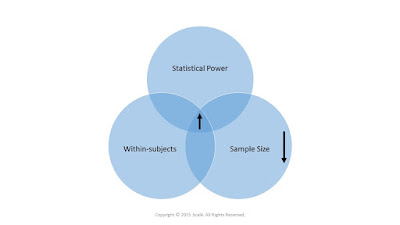Between-subjects database designs are structured around grouping variables. http://www.scalelive.com/between-subjects-database.html #database #statistics
This blog presents useful research and statistical methods for researchers and graduate students from the world's first automated decision tree for applied research and statistics, Research Engineer (www.scalelive.com).
Saturday, January 30, 2016
Thursday, January 28, 2016
Retrospective cohort designs help researchers establish relative risk and longitudinal effects. http://www.scalelive.com/retrospective-cohort.html #research
Wednesday, January 27, 2016
Validate your statistical findings using the bootstrap method. http://www.scalelive.com/bootstrap.html #statistics #bootstrap #spss
Monday, January 25, 2016
Cronbach's alpha is an internal consistency measure of reliability used for Likert-type response sets. http://www.scalelive.com/cronbachs-alpha.html #psychometrics #reliability
Sunday, January 24, 2016
Compare two observations of an ordinal outcome across time or within-subjects. http://www.scalelive.com/wilcoxon.html
Saturday, January 23, 2016
Descriptive statistics are used to describe samples and give context to inferential statistics http://www.scalelive.com/descriptive-statistics.html #statistics
Thursday, January 21, 2016
Curriculum vitae for R. Eric Heidel, Ph.D, Owner and Operator of Scalë, LLC and Research Engineer. http://www.scalelive.com/statistical-forum/curriculum-vitae-for-eric-heidel-phd-owner-and-operator-of-scale-llc-and-research-engineer
Wednesday, January 20, 2016
Intention-to-treat analysis is a necessary part of any randomized controlled trial. Intention-to-treat analysis means that all participants are analyzed in the groups that they were originally assigned to at the beginning of a trial (using random assignment), regardless of attrition or loss to follow-up. http://www.scalelive.com/intention-to-treat.html
Monday, January 18, 2016
Multiple regression is used to predict for continuous outcomes. http://www.scalelive.com/multiple-regression.html
Sunday, January 17, 2016
Within-subjects designs increase statistical power because each participant serves as their own control. http://www.scalelive.com/statistical-power-and-within-subjects-designs.html #research
In order to conduct an a priori sample size calculation for a repeated-measures t-test, researchers have to hypothesize how much of a difference will exist between the pre/baseline observation and the post-observation as a result of treatment. The absolute difference between observations of means and standard deviations and proportions is the effect effect size. Researchers should seek out evidenced-based measure of effect from a published article that is theoretically, conceptually, or pathophysiologically similar. This adds internal validity to the study and is preferable to just "throwing" numbers around regarding sample size. The methods for conducting and interpreting an a priori sample size calculation for repeated-measures t-test in G*Power. http://www.scalelive.com/sample-size-for-repeated-measures-t-test.html
Friday, January 15, 2016
Access the methods for conducting and interpreting 10 forms of regression in SPSS, including logistic regression, multinomial logistic regression, proportional odds regression, multiple regression, Poisson regression, negative binomial regression, simultaneous regression, stepwise regression, and hierarchical regression. www.scalelive.com/regression.html #statistics #spss
Wednesday, January 13, 2016
The nonequivalent control group design is a type of quasi-experimental design where groups are randomly assigned at the level of treatment to reduce confounding. http://www.scalelive.com/nonequivalent-control-group-design.html
Tuesday, January 12, 2016
The PICO mnemonic is used to write valid and answerable research questions. PICO stands for population, intervention, comparator, and outcome. PICO helps researchers to operationalize and define important parts of a research study. http://www.scalelive.com/pico.html
Monday, January 11, 2016
The magnitude of an effect size effects the sample size needed to have adequate statistical power. http://www.scalelive.com/statistical-power-and-effect-size.html #statistics
Sunday, January 10, 2016
Predictive validity is the ability of a measure to predict for future occurrences. Predictive validity is established using correlations and regression. http://www.scalelive.com/predictive-validity.html
Saturday, January 9, 2016
Absolute risk reduction is used to understand the magnitude of an efficacious treatment effect. http://www.scalelive.com/absolute-risk-reduction.html#epidemiology
Thursday, January 7, 2016
Reliability is the consistency, precision, and stability of outcomes and measures. http://www.scalelive.com/reliability.html
Wednesday, January 6, 2016
The FINER and PICO mnemonics are used to write valid and answerable research questions. http://www.scalelive.com/statistical-forum/finer-and-pico #research
Tuesday, January 5, 2016
Odds ratios with 95% confidence intervals are used as a measure of association between two categorical variables. Odds ratios are also reported and interpreted in logistic regression, multinomial logistic regression, and proportional odds regression. Finally, odds ratios are used alongside measures of prevalence in epidemiological studies. http://www.scalelive.com/odds-ratio.html
Monday, January 4, 2016
Structure a database to run all kinds of statistical tests in SPSS. http://www.scalelive.com/multivariate-database.html
Saturday, January 2, 2016
Multivariate statistics can help answer complex research questions. http://www.scalelive.com/multivariate-statistics.html #research #statistics #spss #researchengineer
Subscribe to:
Comments (Atom)





















